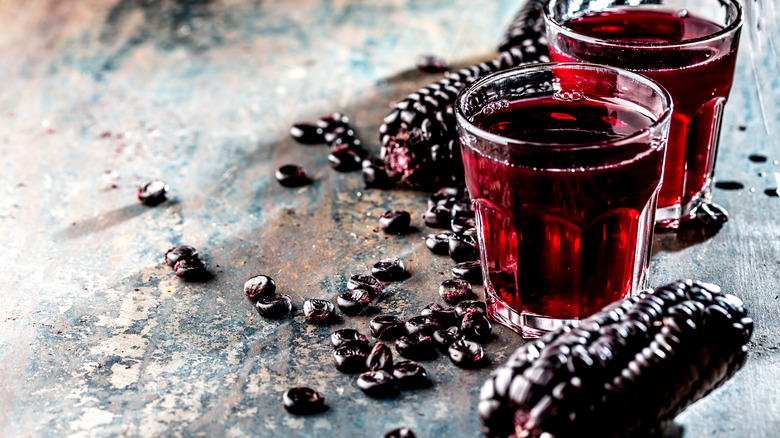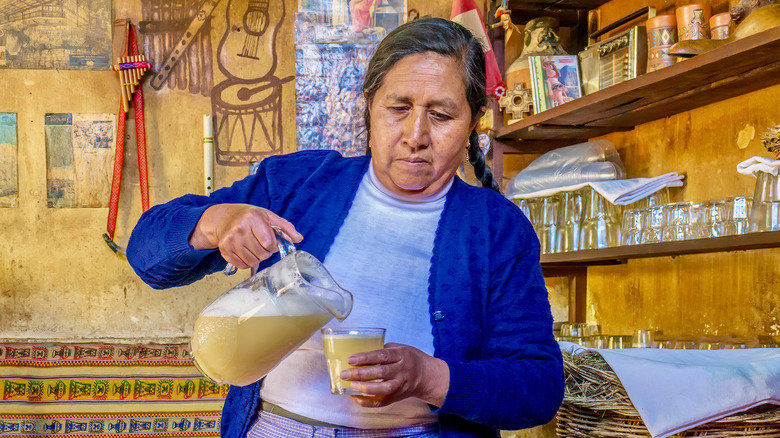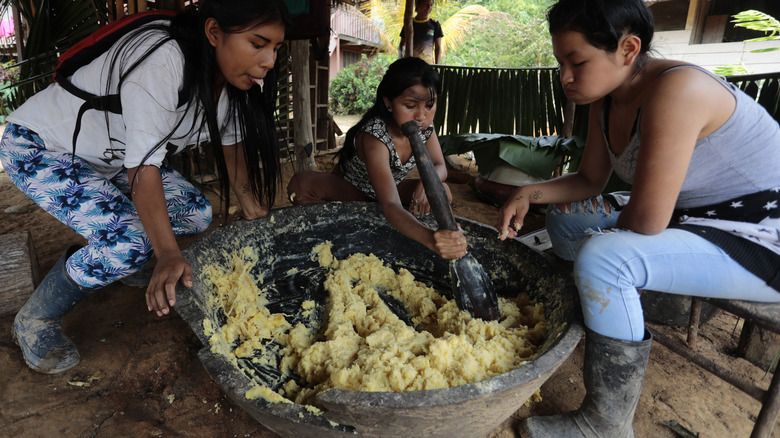One Peruvian Drink Uses Purple Corn As An Ingredient
Corn is truly one of the most miraculous and versatile crops that has come into existence. In addition to its culinary utility as a grain, we can also get oil, syrup, whiskey, animal feed, and even biofuel from corn. But most importantly, it's got the juice! Corn-based beverages have been around for literally thousands of years. Corn's humble origins began in Mexico around 9,000 years ago as a wild herb called teosinte, says National Geographic, which, over generations of selective cultivation, developed into a more recognizable species of maize. Not long after corn cultivation caught on in Central Mexico, the crop traveled to North and South America, where it diversified into a handful of varieties that were integrated into the foodways of other ancient indigenous peoples.
In the Andean region of Peru, purple maize held cultural significance and was a dietary staple for pre-Incan civilizations. It was typically made into a traditional fermented beverage that was incorporated in various religious and political ceremonies, according to the Journal of Ethnic Foods. The popularity of the sacred drink still persists today; the incorporation of purple corn allowed the drink to become an icon of Peruvian indigenous identity and may offer some unexpected health benefits.
Chicha and Peru
Chicha is the general term for the traditional South and Central American corn-based beverage that has been consumed for thousands of years. According to the Ohio State University, chicha is made in many variations across different regions, countries, and groups. Though some variation of chicha was consumed throughout the Americas anywhere corn was harvested, the drink in recent years has become a symbol of Peruvian cuisine and indigenous Andean cultural identity.
In pre-colonial societies, chicha was used in toasts to pay respect to the ancestors, as well as a way of strengthening social ties and reaffirming social hierarchies. But during colonization, chicha consumption was restricted by Spanish authorities in an effort to undermine indigenous religious and cultural traditions. Following the Indigenismo movement in Latin America, where indigenous communities sought to assert more native cultures and traditions in the post-colonial national identities, chicha finally saw its revival as the iconic purple corn drink of Peru (via American Indian Magazine).
How chicha's made
In the most traditional fashion, chicha is made by chewing maize, in order to break down the hard-shelled kernels, and spitting it back out into a container. The natural enzymes in saliva convert the high starch content of maize into maltose (sugar), according to Ohio State University. Essentially a Peruvian purple corn beer, the chewed corn is boiled or brewed and then strained and left to ferment for one to two days before being served (via American Indian Magazine). More contemporary methods of preparing chicha just require brewing corn flour with additional ingredients, circumventing the need for chewing the kernels. Even easier, Peruvian chicha producers now distribute ready-mix powders and syrups to make chicha in a matter of minutes along with mass produced bottled and canned soft-drink versions of the beverage. These days, one of Peru's chief exports is a variation of chicha called chicha morada, which stays true to traditional recipes by using native Andean purple corn.
As previously discussed, purple maize was originally cultivated in the Andes. It has a beautiful deep hue, and rich cultural significance, but what else makes purple corn so special? In a study published by the Journal of Ethnic Food, researchers found that traditionally prepared chicha de güiñapo, made with locally grown purple corn that had been partially germinated, had health-relevant potential in terms of antioxidants and hyperglycemia management.


